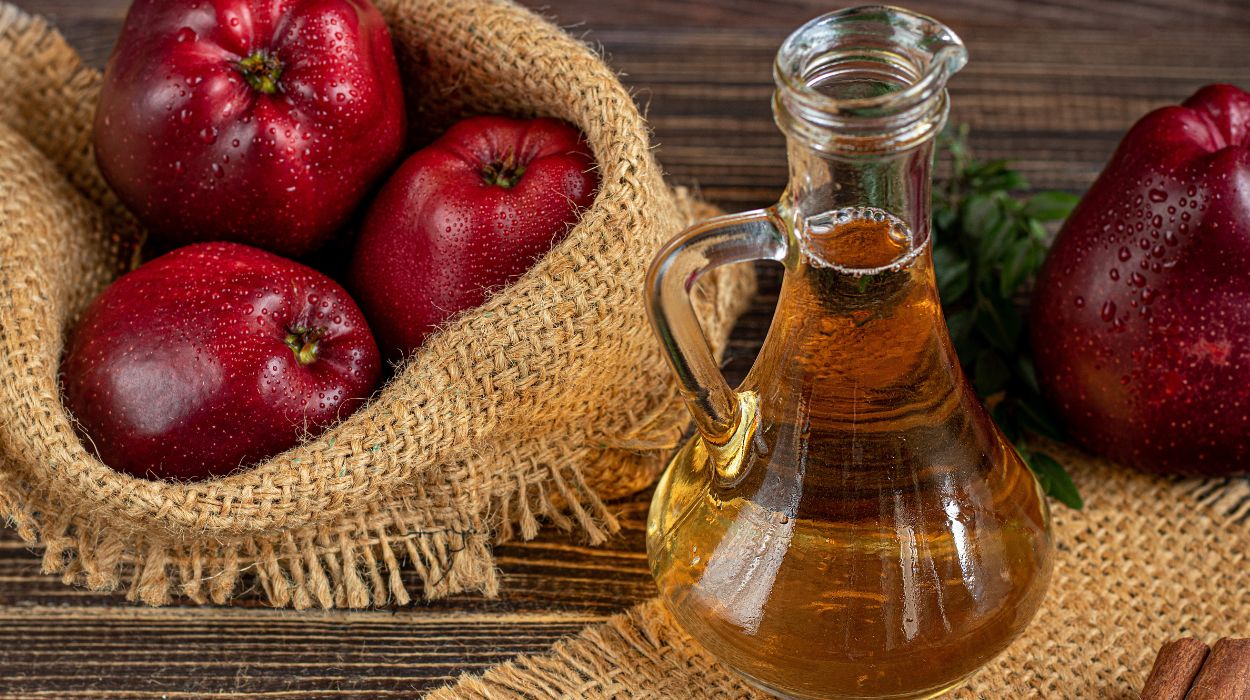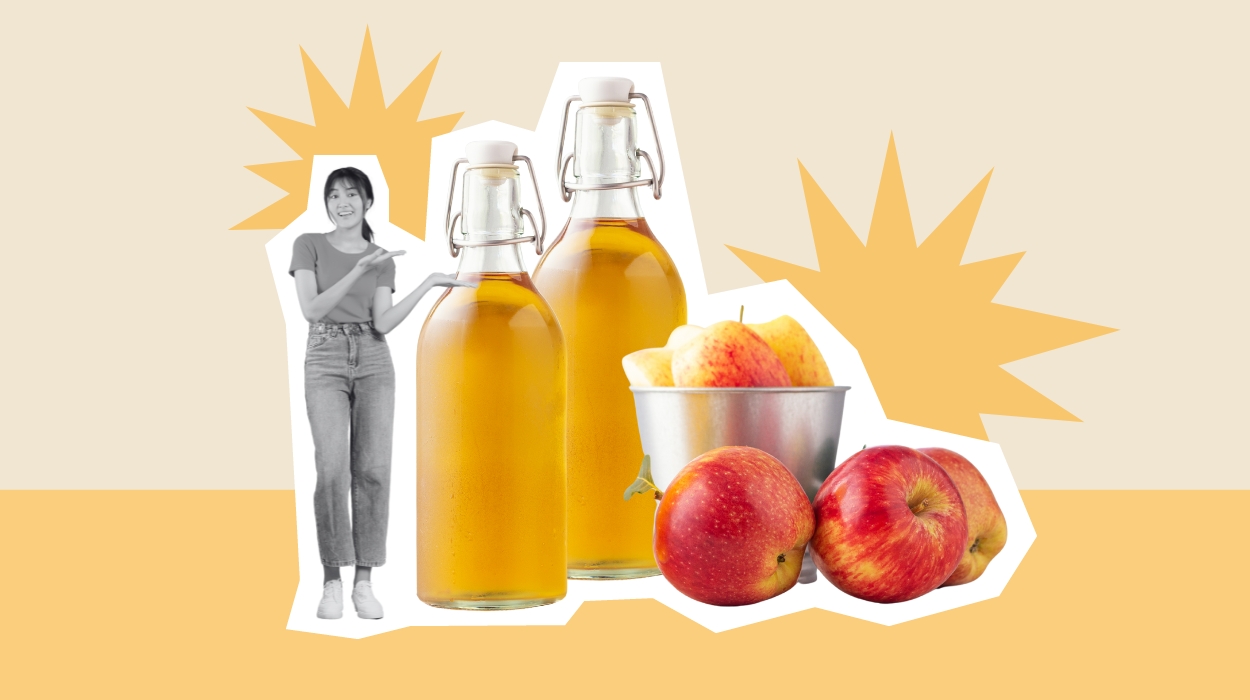Vinegar made from fermented apple juice is called apple cider vinegar or ACV. Vinegar is well-known for its culinary uses, but it is also thought to have some health benefits. The apple cider vinegar benefits for women leads some women to partake in it.
Perhaps you’re curious about how to make homemade apple cider vinegar. The greatest part is that you can easily make apple cider vinegar in the comfort of your home. We typically use whole apples, but you can also use apple scraps to produce apple cider vinegar.
One popular technique is gradually accumulating leftover apple cores and skins and storing them in the freezer before making ACV. Continue reading to find out how to make apple cider vinegar from apple cider juice or apple leftovers. You’ll also learn about the benefits of apple cider vinegar.
n keyword needed in first 300 words Introduction content Introduction content Introduction content Introduction content Introduction content Introduction content Introduction content Introduction content
Six Steps To Make Homemade Apple Cider Vinegar
Many people rely on apple cider vinegar for its health advantages, but how is it made? Here are some steps that could help:
- Step 1: Select and prepare apples.
- Step 2: Add sugar and water.
- Step 3: Ferment and stir daily for two weeks.
- Step 4: Strain the solids.
- Step 5: Second fermentation.
- Step 6: Bottle and enjoy.
How To Make Apple Cider Vinegar
You’re probably asking, how can I make apple cider vinegar? To make apple cider vinegar, gather the following essential items:
- Fresh whole apples or apple scraps.
- Sugar.
- Filtered water (do not use tap water).
- A sterilized glass jar.
- A cheesecloth or any breathable cloth.
- Rubber band.
Instructions:
Select And Prepare Apples

Begin by selecting from a wide range of fresh, ripe apples. To achieve a beautiful polish, give them a thorough wash without soap. Dice the apples into bite-size pieces. The apple stems, seeds, cores, peels, and skin can be left intact. This ensures the strength and purity of your apple cider vinegar.
Using apple leftovers makes the technique much simpler. No preparation is required. Allow your frozen apple leftovers to defrost before using them. A good fermentation is not cold! Consider blending fresh apples and frozen apple scraps. This ensures that live bacteria are added to your brew.
Apple cider vinegar’s live bacteria usually originate from the fermentation process, which is a natural process that turns sugars into acetic acid.
Fill your chosen glass container halfway with these apple pieces.
Add Sugar And Water
The next step is to supply the bacteria with food and water. Combine sugar and water in the glass jar in equal proportions.
Fill up the glass jar with filtered water that is room temperature to lukewarm. Be sure to keep track of the amount of water you add while you proceed. Now, stir in one tablespoon of sugar for every cup of water added, adjusting the proportions and sugar content as required.
Continue to swirl until the sugar has dissolved. This precise coordination sets off the complex fermentation process, as sugar acts as food for the beneficial microbes.
Ferment And Stir Daily For 2 Weeks
After you’ve mixed everything in the glass jar, cover it with a clean, breathable towel and fasten it with a rubber band. This covering is a protective barrier to keep fruit flies away from the apples during fermentation.
Store your homemade apple cider vinegar mixture in a warm place away from direct sunlight to promote the fermentation process. In the first two weeks of fermentation, stir the mixture daily. The idea is to alternate which bits are floating on top and prevent the sugar from sinking to the bottom. As a result, fermentation occurs,[1] and a diverse population of beneficial bacteria, yeast, and enzymes will flourish.
Strain The Solids
After two weeks of daily stirring, drain the apples to separate them from their liquid.
Pass the contents of the jar through a cheesecloth, fine-mesh strainer, coffee filter, or other suitable device to separate the juice from the solids. This method separates the pure liquid from the apple cider vinegar solids, resulting in a greater concentration of the vinegar’s therapeutic components.
Transfer the collected liquid to a clean, empty glass jar and seal it as before.
Second Fermentation
Allowing apple cider vinegar to brew again improves its flavor.
For best results, place your covered crock somewhere cool and dark for at least a month, but preferably longer! The bacteria will continue to convert sugar or alcohol into acetic acid, yielding vinegar.
After a month, you can analyze the vinegar’s flavor. If you are satisfied with the vinegar taste, proceed to the next stage. If it still doesn’t taste vinegary enough for your liking, let it ferment longer, probably a few weeks.
This secondary fermentation procedure aims to improve your apple cider vinegar, transforming it into a more refined culinary addition.
Bottle And Enjoy

The final step is to bottle the apple cider vinegar you’ve made. When the fermenting process is complete, pour the apple cider vinegar into clean, airtight, and sterilized containers. Keep the bottles in a cool, dark place to keep the flavors from setting.
Now, you may use ACV in a number of recipes, meals, healthy home and body care products, and more.
Benefits Of Apple Cider Vinegar
It appears that those looking for alternative health support are more interested in natural solutions. Research has shown that apple cider vinegar has several beneficial properties,[2] including anti-inflammatory,[3] antioxidant, and natural antibacterial properties.
Apple cider vinegar has a tart flavor that not everyone enjoys. Alternatives to taking it straight from the bottle include nutritional supplements. Anyone who wants to try apple cider vinegar for its natural antibacterial benefits but can’t stand the taste of strong vinegar could find that ACV candies or pills are more to their liking.
Support For Cardiovascular System
Potential dangers to health include cardiovascular disease, hypertension, and high cholesterol levels.[4] For this reason, it is wise to seek methods to reduce total and LDL (bad) cholesterol levels for improved health.
Improving cholesterol levels is best accomplished with regular exercise and a healthy diet. One of the most compelling arguments in favor of apple cider vinegar, though, is its purported ability to lower total cholesterol.
A recent study conducted in 2023 found that consuming ACV lowered risk factors for heart disease,[5] including total cholesterol and fasting blood sugar.
Supports Weight Loss
Does using apple cider vinegar regularly really help with weight loss? It could!
The evidence supporting using apple cider vinegar for weight loss is limited. There is some evidence[6] that, for a limited time, apple cider vinegar can aid with appetite suppression and portion control.
To curb your hunger for around 120 minutes, try drinking some apple cider vinegar with or before each meal. Drinking apple cider vinegar multiple times a day may make it easier to reduce calories, which is essential to lose fat.
Supports Your Digestive And Gut Health
ACV has also been linked to gut health benefits.
Vinegar has acetic acid, which may act as a digestive aid by helping break down food and lessen gas, indigestion, and acid reflux. Because of its probiotic component, ACV may improve digestive health.[7] The good bacteria found in apple cider vinegar can aid in maintaining a balanced gut microbiota, promoting digestive health.
Supports The Immune System
There is some evidence that drinking apple cider vinegar may help the immune system. Because of its antimicrobial properties,[8] apple cider vinegar may prevent the growth of Staphylococcus aureus, Candida albicans, and Escherichia coli.
Skincare Benefits
A little apple cider vinegar applied to the face can do wonders for the skin. People who suffer from eczema or atopic dermatitis turn to apple cider vinegar as a home remedy. Some people find that soaking their skin[9] in apple cider vinegar helps with itching and dryness, but research shows that this is not beneficial.
Because healthy skin is slightly acidic, skin diseases like eczema can cause skin to become less acidic, which is undesirable. Diluted apple cider vinegar applied topically[10] can help restore the skin’s color and shine.
Supports Women’s Health
There is some evidence that ACV can help women manage yeast infections. The treatment of polycystic ovary syndrome or PCOS[11] is another potential female advantage of apple cider vinegar. Research on animals has shown that ACV can reduce insulin resistance and aid in regulating PCOS-related hormones. However, there is insufficient research on the human response to apple cider vinegar’s hormonal benefits.
How To Store Your Apple Cider Vinegar
Proper storage of ACV is essential for maintaining nutritional levels, protecting natural bacteria, and minimizing adverse side effects. The conditions under which you store your apple cider vinegar impact its quality and shelf life.
Experts recommend precise storage strategies for your ACV. Vinegar is highly acidic and can leach plastic particles into your ACV, so avoid using a plastic container. Put it in a tightly sealed glass bottle and keep it in a cold, dark spot, like the kitchen pantry, away from heat and sunlight.
Conclusion
The biologically active components of ACV suggest that it may have some protective health effects. Included in apple cider vinegar are nutritional components with antioxidant capabilities.[12] That is why following the basic steps outlined above is vital when preparing ACV at home.
Remember that manufacturing apple cider vinegar needs patience, accuracy, and commitment. Thus, be sure to follow every instruction properly, from selecting the best apples to promoting fermentation.
Frequently Asked Questions
if you’re curious about how to create ACV, it’s easy. Crush some apples, mix them with some sugar and water, and then let them ferment.
Yes, it is generally safe when prepared properly using clean equipment and ingredients.
Herbs, fruits, and spices can be added to ACV during fermentation to improve its flavor.
When stored properly and away from direct sunlight, homemade vinegar can last anywhere from 6 months to a year.
No, it is safer to store in glass bottles to prevent chemical leaching.
 Evidence Based
Evidence Based
